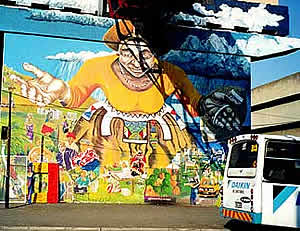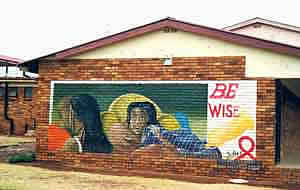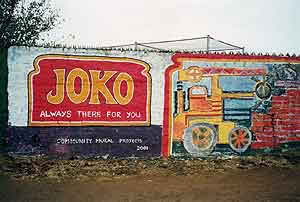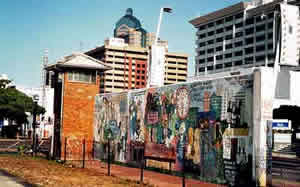|
Back to Index
Protest
in colour: Murals in South Africa
Kim Poldner,
Africancolours.net
January, 2007
http://southafrica.africancolours.net/content/11196%22%20target=%22_blank
You see them
everywhere in South Africa. Colourful paintings on walls of bus
stations, prisons and libraries. Painted by professional visual
artists, often together with children and people from the neighbourhood.
In Europe you don’t find them often, but you can admire them all
over the Caribbean and in African countries such as South Africa.
They are often works of art that visualize a protest against the
political climate or images which show developments in society.
Popular
South
Africa has a rich but bloody history. For years the country moaned
under Apartheid and millions of people suffered from poverty and
racism. After the release of Nelson Mandela in ’92, murals quickly
appeared in the streets. Some of them expressed a growing dissatisfaction
with the status quo. Others were a means to inform and empower a
large group of poor and illiterate people. After the democratic
elections in 1994 murals became more and more popular. Especially
after the new government actually allowed people to paint them.
 |
| Image Courtesy of
Community Mural Projects Trust |
Aids
education
During
the mid nineties the country struggled with new problems. AIDS hit
the records and millions of people became infected with the HIV
virus. The new government discovered the power of murals and used
them as a tool to educate. Artists were commissioned to paint images
of people in love, showing condoms and the famous AIDS ribbon. They
were messages to encourage people to have safe sex.
 |
| Image
Courtesy of Community Mural Projects Trust |
Rainbow
Nation
Not
only AIDS is a favourite topic in murals. Democracy, freedom and
images of daily life are popular too. Traditional stories that used
to be told around the campfire are now being visualised in images
on the wall. Another theme is ‘rainbow nation’, a term introduced
by president Thabo Mbeki. As a reaction to Apartheid, he wanted
to focus on the colourful diversity of people in his country. In
murals you often find people with different skin colours brotherly
depicted next to each other.
Different
functions
This
is one of the characteristics that make murals so unique: it can
be a tool to bring people together. While painting, artists from
different backgrounds work side by side on one mural. A work of
art can also provide a bridge between cultures when it is painted
on a strategic location on the border of two segregated areas (for
example a black and white township). Apart from being a bridge,
an educational tool and a sign of protest, murals have a decorative
function. They brighten up dull public buildings, bring colour in
the streets and give people something to think about.
 |
| Image
Courtesy of Community Mural Projects Trust |
Graffiti
Murals
are often related to graffiti because they are painted in public
places. But there are important differences between both art expressions.
Graffiti is painted with spray cans while murals are painted with
paint and brush. Graffiti often exists of texts and slogans, while
murals show more images. Graffiti often has an illegal character
while permission needs to be granted for painting a mural. A last
difference between graffiti and murals is that murals are often
painted by a group of professional artists, while graffiti can be
an activity of a rebellious individual.
 |
| Image
Courtesy of Community Mural Projects Trust |
Advertisement
Nowadays
a lot of murals function as billboards for advertising campaigns.
Some people view this development as degradation of the art. Opponents
point out the advantage of employment for artists. Companies often
pay well when they commission an artist to paint a mural. And not
only professional artists earn a salary this way, other talented
people who help with the painting process, can make some money too.
Monument
and tourist attraction
A
lot of murals are temporary depictions of society. They are often
not being valued and sometimes get destroyed or painted over. Fortunately
others make their way to becoming a monument or even a tourist attraction.
Because they make an important statement or are dated in a historical
timeframe such as the first democratic elections in the mid nineties.
People in the neighbourhood will respect the mural because it is
a way to generate income when tourists visit. In that way an important
document of South-African history can be preserved.
*Kim Poldner
holds a BA in art and an MA in Sociology. She wrote her thesis on
the South-African mural art scene. After that she organized an exchange
project between young Dutch and South African artists. Together
they created a large ‘freedom’ mural in the city of Amsterdam.
Please credit www.kubatana.net if you make use of material from this website.
This work is licensed under a Creative Commons License unless stated otherwise.
TOP
|

